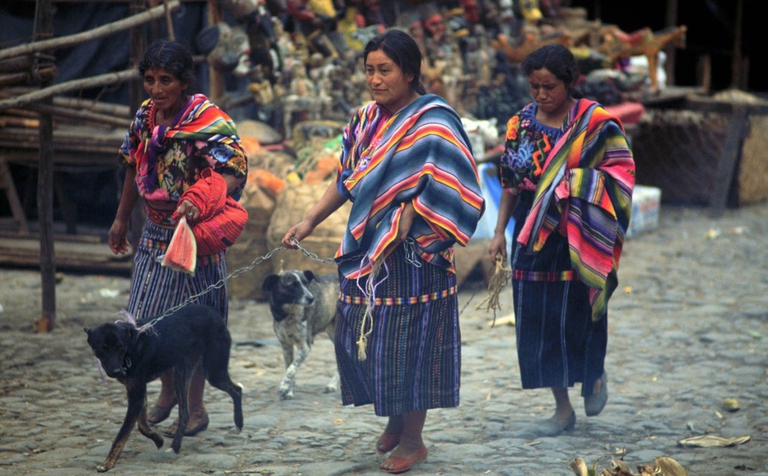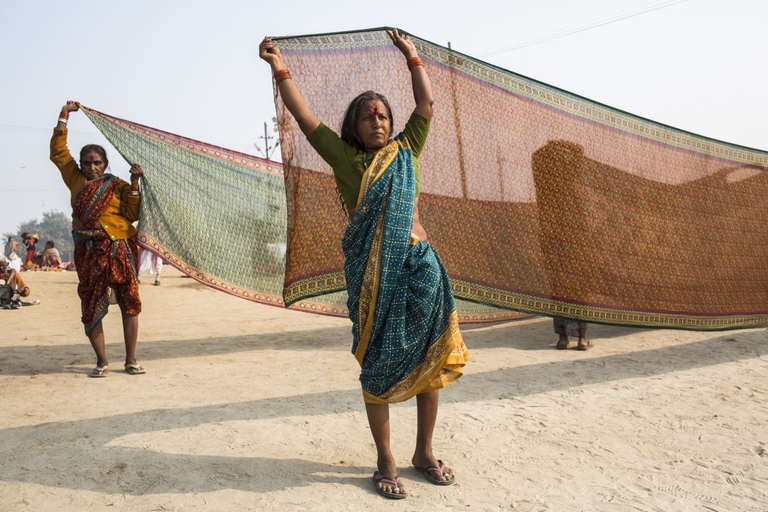
A special report from the Yuqui territory delves deep into the dreams, challenges, joys and sadness of one of Bolivia’s most vulnerable indigenous groups.
Why are the fabrics of the south of the world so colourful and showy? Let’s discover together the colours and patterns used by indigenous peoples for realising fabrics.
Clothes, as well as food, tell the story of the place and culture to which they belong. We can consider clothes as a display of deep meanings, which go beyond their concrete function, i.e. covering and adorning the body.
Clothes have always been an important means of communication at a social, historical and cultural level. Depending on the geographical area, historical period and social context fashion changes according to culture. With their colourful and shocking tissues as well as patterns indigenous people clearly express the communicative value lying behind every single garment.
Before the Spanish invasion in the Americas, under the ancient Aztec empire that controlled Central America (Mexico, Guatemala and Honduras), a type of cloth that still exists today spread. This is the huipil, a sort of loose-fitting tunic with an opening for the head and the sides sewn, made of cotton or wool, available in different lengths. Over the centuries this garment has often been a source of inspiration for fashion. But it keeps its original meanings just among the indigenous people because the colourful and stylised decorations have an important symbolic role: they tell true legends revealing the origin of the woman wearing the huipil.
The symbols used in the decorations include snakes, which are connected to the goddess of midwifery and that of water and represent a woman’s gift of giving life and protection; double-headed eagles that indicate the duality of good and evil, sky and earth or past and future; and many other representations of myths and beliefs of different tribes.
African prints, the wonderful colourful fabrics worn by African women, are known and spread worldwide. It’s not by chance that starting from 1800 western countries (mostly UK and Netherlands), charmed by the sublime beauty of these fabrics, have started outsourcing the production of these exotic clothes exactly to this continent. Thanks to the long tradition of Western Africa (Senegal, Burkina Faso and Congo), local artisans have acquired remarkable skills in decorating fabrics of raw cotton. There are as many as three techniques to realise these tissues that give their names to three different types of African prints: fancy is roller printed; java is decorated with an oxidant product that is applied after dyeing; superwax is tie-dyed twice to create different shades.
Decorations have a strong symbolic meaning even in Africa. The pyramid, for example, indicates awareness of a social hierarchy in which powerful people elevate themselves and illuminate the path that everyone should walk; the sheaf of wheat symbolises the difficulties of marriage because one can discover what it contains just by opening it; brooding hens with chicks represent the fundamental role of mothers in a family who bring together the family members as well as protect their offspring.
These are some of the original meanings. Today there are new meanings. For example alphabet letters indicate the education of the person who wears the cloth and the other modern elements include lorries, cell phones etc.
The importance of fabrics in this country is celebrated with a “charka” (a particular Indian loom) on the national flag. But, besides the particular processing techniques of tissues, India produces traditionally colourful clothes that were originally made with natural dyes derived from spices.
Two main techniques are used to create decorations: batik, consisting in covering the areas that won’t be dyed with wax, clay, resin or starch, thus preventing dyes from being absorbed; and block print consisting in dyeing tissues with pieces of wood that are used as moulds.
Contrary to other indigenous cultures, the true symbology of Indian inhabitants lies in colours themselves. The colours of saris, the traditional draped costume that Indian women pass down from generation to generation since 100 a.C., stand for a precise social condition. Red, the colour worn by brides represents fertility and sensuality; yellow is the colour of spirituality and birth, and is worn by women who have recently given birth; white is the colour of mourning.
There are many places in the world worth visiting at least once in a lifetime. Obviously those with a long tradition are a good starting point. Even just to taste the authenticity that has never ceased to be charming.
Siamo anche su WhatsApp. Segui il canale ufficiale LifeGate per restare aggiornata, aggiornato sulle ultime notizie e sulle nostre attività.
![]()
Quest'opera è distribuita con Licenza Creative Commons Attribuzione - Non commerciale - Non opere derivate 4.0 Internazionale.
A special report from the Yuqui territory delves deep into the dreams, challenges, joys and sadness of one of Bolivia’s most vulnerable indigenous groups.
The Yuqui people of the Bolivian Amazon fight not only to survive in the face of settlers, logging and Covid-19, but to preserve their culture and identity.
Jair Bolsonaro is accused of crimes against humanity for persecuting indigenous Brazilians and destroying the Amazon. We speak to William Bourdon and Charly Salkazanov, the lawyers bringing the case before the ICC.
Activists hail the decision not to hold the 2023 World Anthropology Congress at a controversial Indian school for tribal children as originally planned.
Autumn Peltier is a water defender who began her fight for indigenous Canadians’ right to clean drinking water when she was only eight years old.
The pandemic threatens some of the world’s most endangered indigenous peoples, such as the Great Andamanese of the Andaman and Nicobar Islands in India.
By recovering clothes discarded in the West, Togolese designer Amah Ayiv gives them new life through his high fashion creations.
The Upopoy National Ainu Museum has finally opened. With it the indigenous people of Hokkaido are gaining recognition but not access to fundamental rights.











